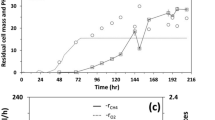Abstract
Detailed kinetic and thermodynamic parameters for lysine production from Brevibacterium lactofermentum are investigated for the first time in this study. Production of the essential amino acid, l-lysine, by B. lactofermentum was assessed in a flask and a continuously stirred tank fermentor (22 L). Maximum lysine production was achieved after 40 h of growth and at 35 °C. The effect of different nitrogen sources such as NH4NO3, (NH4)2SO4, (NH4)2HPO4, corn steep liquor, NaNO3, and urea showed that corn steep liquor gave a better lysine yield. Lysine production was increased when dissolved oxygen was maintained at 50 % saturation. The use of dissolved oxygen was critical for high productivity. This indicates that dissolved oxygen greatly affects l-lysine productivity. Kinetic and thermodynamic parameters during lysine production from molasses and glucose mixture showed that B. lactofermentum efficiently converted the substrate mixture into cell mass and lysine. Kinetic and thermodynamic parameters were significantly higher compared with other microorganisms which may be due to the high metabolic activity of B. lactofermentum. This study will have a significant impact on future strategies for lysine production at industrial scale.


Similar content being viewed by others
References
Wendisch, V. F., Bott, M., Kalinowski, J., Oldiges, M., & Wiechert, W. (2006). Journal of Biotechnology, 124, 74–92.
Leuchtenberger, W., Huthmacher, K., & Drauz, K. (2005). Applied Microbiology and Biotechnology, 69, 1–8.
Sattar, M., Ahmed, S., Sheikh, M. A., & Hashmi, A. S. (2008). Journal of the Chemical Society of Pakistan, 30, 642–648.
Sallam, A., & Steinbüchel, A. (2010). Applied Microbiology and Biotechnology, 87, 815–828.
Ali, S., Ahmed, S., Sheikh, M. A., Hashmi, A. S., Rajoka, M. I., & Jamil, A. (2009). Journal of the Chemical Society of Pakistan, 31, 97–102.
Koffas, M., & Stephanopoulos, G. (2005). Current Opinion in Biotechnology, 16, 361–366.
Wittmann, C., & Becker, J. (2007). In V. F. Wendisch (Ed.), Amino acid biosynthesis: pathways, regulation and metabolic engineering (pp. 39–70). Heidelberg: Springer.
Ekwealor, I. A., & Obeta, J. A. N. (2005). African Journal of Biotechnology, 4, 633–638.
Athar, M., Ahmed, S., & Hashmi, A. S. (2009). Journal of the Chemical Society of Pakistan, 31, 115–121.
Rajoka, M. I., Ahmed, S., Athar, M., & Hashmi, A. S. (2012). Annals of Microbiology, 62, 1173–1179.
Aiba, S., Humphrey, A. E., & Millis, N. F. (1973). In: Biochemical engineering (2nd ed., pp. 92–127). New York: Academic Press.
Association of Official Analytical Chemists (1984) Official methods of analysis, 14th edn. Washington, DC: AOAC International. ISBN 0-93558424-2.
Rajoka, M. I., Khan, S. H., Jabbar, M. A., Awan, M. S., & Hashmi, A. S. (2006). Bioresource Technology, 97, 1934–1941.
Rajoka, M. I., Khan, S., & Shahid, R. (2003). Food Technology and Biotechnology, 41, 315–320.
Rajoka, M. I., Latif, F., Khan, S., & Shahid, R. (2004). Biotechnology Letters, 26, 741–746.
Chen, J., Lu, Z., Sakon, J., & Stites, W. E. (2000). Journal of Molecular Biology, 303, 125–130.
Converti, A., & Dominguez, J. M. (2001). Biotechnology and Bioengineering, 75, 39–45.
Converti, A., & Del Borghi, M. (1998). Bioprocess Engineering, 18, 27–33.
Leuchtenberger, W. (1996). Applied Microbiology and Biotechnology, 6, 455–502.
Kiefer, P., Hienzle, E., & Wittman, C. (2002). Journal of Industrial Microbiology and Biotechnology, 28, 338–343.
Gayen, K., & Venkatesh, K. V. (2007). Journal of Industrial Microbiology and Biotechnology, 34, 363–372.
Demain, A. L., Phaff, H. J., & Kurtzman, C. P. (1998). In C. Kurtzmann & J. Fell (Eds.), The yeasts - a taxonomic study (4th ed., pp. 13–19). Amsterdam: Elsevier.
Nigam, J. N. (2000). Journal of Biotechnology, 80, 189–193.
Ahmed, S., Ahmad, F., & Hashmi, A. S. (2010). Pakistan Journal of Botany, 42, 1225–1234.
Acknowledgments
The authors would like to thank University of Agriculture, Faisalabad, 38040, Pakistan and National Institute for Biotechnology and Genetic Engineering, Faisalabad, Pakistan for providing financial support to carry out this project.
Author information
Authors and Affiliations
Corresponding authors
Rights and permissions
About this article
Cite this article
Ahmed, S., Afzal, M. & Rajoka, M.I. Kinetic and Thermodynamic Characterization of Lysine Production Process in Brevibacterium lactofermentum . Appl Biochem Biotechnol 170, 81–90 (2013). https://doi.org/10.1007/s12010-013-0169-3
Received:
Accepted:
Published:
Issue Date:
DOI: https://doi.org/10.1007/s12010-013-0169-3




